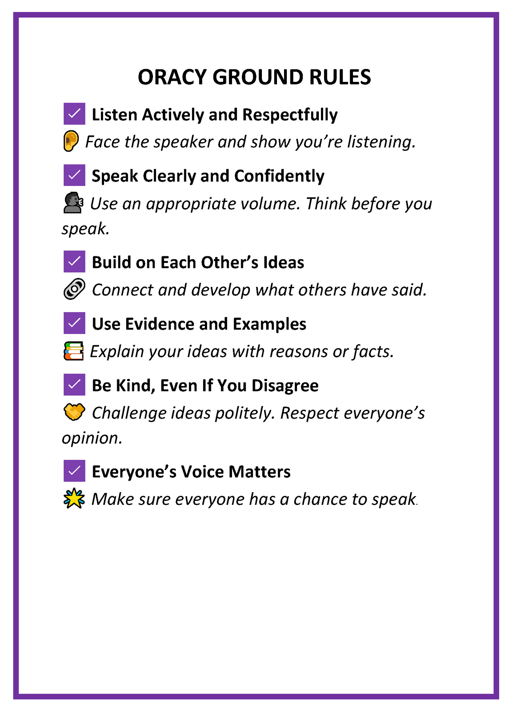Curriculum
At The Oaks Academy our vision is to ensure that all pupils build the dignity and positive self-esteem that being able to speak, read, and write with fluency brings, this is embedded in our Literacy Strategy. The Oracy Framework is therefore designed to complement academic literacy across the curriculum.
Vision
We inspire our students to become confident, fluent speakers by developing their voice across the four strands of oracy: physical presence, linguistic ability, cognitive skill, and social-emotional awareness.
We believe that every learner deserves the opportunity to express themselves, listen with empathy, and engage in meaningful dialogue. Through a dedicated, fortnightly oracy lesson at Key Stage 3 and high-quality talk across the curriculum, we build students' self-belief and communication skills.
We achieve academic excellence by teaching oracy explicitly and embedding it into everyday learning. We empower students to think critically, collaborate effectively, and communicate with clarity—skills that support success in school and in life
Staff are encouraged through Oracy CPD to become more proficient at supporting effective Oracy within the classroom across the whole school. To complement and reinforce this across the curriculum this we will:
- Display Oaks Oracy Posters around the school and in classrooms
- Use Oracy framework to highlight to pupils how to talk when answering questions, delivering presentations or debating.
- Encourage all teachers to integrate oracy tasks into lessons
- Use oracy ground rules and sentence stems across subjects
- Model high-quality talk: show examples of structured arguments, clear delivery, and respectful disagreement
- Provide sentence starters, planning templates, and checklists to support all learners
- Break down the Oracy framework strands:
Physical: Voice projection warm-ups, posture drills.
Linguistic: Vocabulary building, rhetorical devices.
Cognitive: Structuring ideas, using evidence.
Social & Emotional: Turn-taking, active listening, empathy
- Build in frequent low-stakes opportunities: think-pair-share, role-play, mini-presentations
- Rehearse delivery in pairs or small groups before presenting to the class
- Develop routines for starting and ending speaking activities
- Celebrate effort and progress, not just polished performance
- Display sentence stems and key vocabulary
Framework
Physical
The Physical strand of the Framework focuses on the delivery of speech—how students use their voice and body language to communicate clearly and effectively. It develops the audibility, clarity, and presence of students as speakers.
Linguistic
The Linguistic strand focuses on the vocabulary, grammar, and rhetorical techniques used in spoken communication. It supports students in choosing language purposefully to express themselves clearly, accurately, and effectively across a range of contexts.
Cognitive
The Cognitive focuses on the thinking skills involved in effective spoken communication. It supports students in organising their ideas, developing reasoning, and using talk as a tool for learning
Social & Emotional
Under the Social & Emotional strand, the focus is on how students engage with others, manage themselves in discussion, and build confidence in communication. This strand supports the development of respectful, confident speakers who are aware of themselves and others in spoken interactions
Oracy Assessment Grid
|
Strand |
Excellent Progress |
Good Progress |
Some Progress |
|
Physical |
Speaks clearly and audibly with varied tone, pace, and confident body language. |
Mostly clear with some variation in tone and eye contact; growing physical confidence. |
Speech may be quiet or hesitant; limited use of tone, eye contact, or posture. |
|
Linguistic |
Uses precise vocabulary, full sentences, and appropriate register for task and audience. |
Uses appropriate vocabulary and mostly clear sentence structures; some register awareness. |
Limited vocabulary or informal language; unclear sentence structure. |
|
Cognitive |
Ideas are well-structured, justified with reasons/evidence, and built on others’ points. |
Ideas are mostly clear; shows some reasoning or structure; attempts to build on ideas. |
Ideas are underdeveloped or unstructured; struggles to explain or expand points. |
|
Social & Emotional |
Listens actively, takes turns, responds with empathy, and speaks confidently in a group. |
Participates well; shows respect for others' ideas; growing confidence in speaking. |
Reluctant to contribute; may interrupt or show limited engagement with peers. |
.png)
